Due to its durability, variety of decor and ease of installation, linoleum does not lose its popularity in the building materials market. It is laid in apartments, private houses, offices, public buildings. Before starting the installation, it is necessary to resolve the issue of using the substrate. The feasibility of its application depends on the characteristics of the flooring. It will be useful for a home craftsman to learn how to put a linoleum backing on a concrete or wood floor.
Features of linoleum
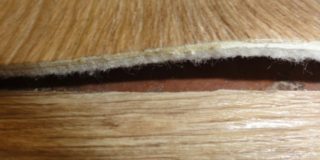
Linoleum is a type of floor covering made from natural or synthetic materials, produced in rolls. It appeared much earlier than laminate and still does not lose its popularity. There are three types of products depending on the purpose:
- Household - the material spreads in houses and apartments, has a small thickness (1-4 mm) and a service life of 2-3 years. A wide range of products allows you to choose colors for any interior.
- Semi-commercial - unlike the household counterpart, the coating is equipped with a protective layer, which increases its abrasion resistance and extends the service life up to 10 years.
- Commercial - strong and durable products for use in shops, offices, classrooms and other high traffic areas. The material has received increased characteristics of moisture resistance, sound insulation, wear resistance. Due to the high cost, it is rarely used in everyday life.
One of the criteria for choosing a floor covering is the presence of a base:
- No base - the material has excellent abrasion and moisture resistance. It is recommended for kitchens, bathrooms, corridors.
- Foam-based - a common option that provides elasticity and resistance to water. The base is made of foamed vinyl.
- On felt or jute base - the material retains heat and absorbs sound, intended for dry rooms.
Thin, homogeneous and baseless linoleum does not provide comfort during operation. They accentuate floor imperfections and create a cool feeling in winter. In this case, laying the substrate under the linoleum is necessary.
Underlay functions

The interlayer between the subfloor has several functions:
- Leveling - eliminates small floor errors that are not critical. She replaces the self-leveling screed if there is no time and desire to engage in wet work.
- Sound insulation - the porous sheet dampens sound waves well. This is a great option for multi-storey buildings.
- Thermal insulation - the lining is an additional insulating layer. It is relevant when installing a floor on the ground, on the first floor, when laying baseless linoleum on concrete.
If the topcoat is laid on a perfectly flat base, and the room is well heated and does not require sound insulation, you can do without an additional layer.
Varieties of substrates
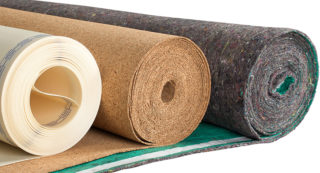
Products differ in composition, main functions and cost. Organic and synthetic materials are used as raw materials.In order for the substrate to perform its functions, it must meet the following requirements:
- Strength and rigidity - soft material quickly crumples under load, it stops leveling floor defects, and thermal insulation deteriorates.
- Resistance to moisture - condensation accumulates on the concrete base, therefore the lining under the linoleum is often in a humid environment.
- Biological stability - the material should not serve as a favorable environment for the development of mold and mildew.
Jute
Natural material made from plant fibers treated with fire retardants. The hygroscopic fabric easily absorbs moisture, does not change its properties after evaporation. Jute provides excellent thermal insulation, does not rot. The main condition is the purchase of high density material.
Foamed
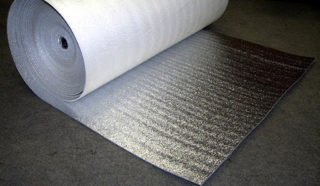
Polyethylene foam has better heat and sound insulation characteristics due to its cellular structure. The synthetic fabric is resistant to moisture and biological effects, absorbs shock loads. There are two types of products - sewn and non-sewn. They differ significantly in strength. Only physically cross-linked polyethylene foam can be laid as an insulating layer under linoleum.
Cork
The eco-friendly material is made from balsa wood without synthetic ingredients. The porous structure of the fabric prevents noise propagation and heat transfer. The addition of an antiseptic protects the cork sheet from rotting, and fire retardants from ignition. The material differs in thickness, a product of 2-3 mm is recommended for linoleum.
Wood-shaving
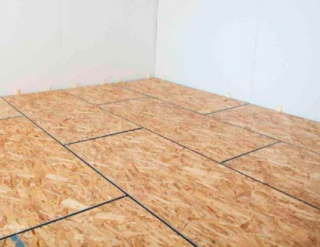
Wood residue boards are often used in construction and renovation work. They are made from sawdust and synthetic resins by pressing and temperature exposure. This group includes:
- Fiberboard - fiberboard;
- Chipboard - chipboard;
- plywood - multi-layer glued veneer.
Wood materials have rigidity, thermal insulation characteristics, and a long service life. With their help, you can quickly create a solid and level base.
Cement-bonded
A composite material made of cement and wood fibers (DSP) is distinguished by moisture resistance, fire safety, resistance to decay, insects and rodents. It combines the strength of concrete and the thermal insulation properties of wood. The material provides good sound insulation, lasts up to 50 years. DSP is a competitor to chipboard and plywood in construction work.
Selecting a substrate by type of floor
Linoleum serves as a topcoat for various types of substrates. To prolong its life, it is necessary to carefully prepare the surface and lay the correct substrate. When choosing a material, the type of floor is taken into account.
Concrete
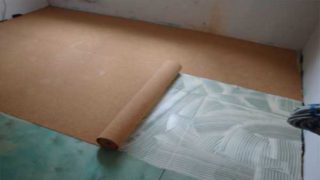
A solid concrete screed is a solid foundation, but it has several drawbacks. It has significant thermal conductivity, so heat losses through the floor are great. On the ground floor of a house or in non-residential premises, the disadvantage is especially noticeable. As an additional layer under baseless linoleum on a screed, it is recommended to use materials that level the minuses of concrete. It is better to choose a natural canvas - jute, cork or combined (jute-linen). The use of foamed substrates gives a good result. They are moisture resistant, serve as a reliable insulator against noise and heat loss.
Wood
Boards wear out over time and require restoration. They are strengthened with nails, polished and putty. A dry and warm base requires additional leveling, which is carried out using plywood, fiberboard or chipboard. This is the easiest and fastest way to prepare the surface for PVC linoleum. Plates are inexpensive, serve for a long time, are easy to cut and assemble.
Warming and soundproofing also do not hurt.Natural substrates are the best option for these purposes. In dry rooms without heavy furniture, they are the best underlayment for flooring.
Bulk

A modern self-leveling floor is a type of screed that forms a monolithic and smooth surface. It serves as a leveling base for the topcoat. There are formulations that solidify after a few hours. There are no irregularities on such a base, an insulating layer is needed to retain heat. A thin foam sheet is suitable.
Tile
If the old coating is made of ceramic tiles, it does not need to be knocked down. It is a solid foundation that needs to be repaired. Seams and chips are leveled before the flooring. To increase sound insulation, an artificial roll material akuflex is suitable. The fibrous cloth compensates for unevenness, provides air circulation, insulates the linoleum from the base. A backing made from a combination of natural materials can be used. It is safe, protects well from the cold.
Infrared
To create comfortable conditions in the house, heating is created not only by radiators, but also by systems mounted on the floor. An infrared film floor is recommended for the apartment. The affordable and convenient heating option is not compatible with all floor coverings. When choosing a material, you should make sure that it will not emit harmful substances, will not warp from temperature.
Under the linoleum on the infrared floor, you can put a substrate. This is a prerequisite for proper installation. After installation and testing of the heating system, the film is covered with a polyethylene layer. On top of it, chipboard is placed on fiberboard. Such a substrate will become a reliable protection for a film or rod infrared floor. It will prevent mechanical damage to the system.
Advantages and disadvantages of lining
The table, which contains the advantages and disadvantages of materials, will help to finally decide on the choice of the lining layer.
| Substrate type | Dignity | disadvantages |
| Natural materials (jute, linen, cork) |
|
|
| Foamed synthetic |
|
|
| Wood-shaving |
|
|
| Cement-bonded |
|
|
When choosing a material for a floor covering, the operating conditions, the compliance of the substrate with the necessary functions, are taken into account.
Laying various materials with your own hands
High-quality preparation of the base is the key to a reliable installation of the floor covering.
Cork canvas
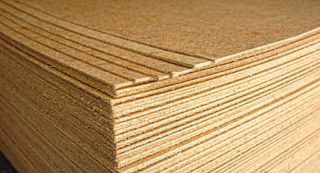
Cork lining is a versatile option that can be laid on any base. When laying on concrete, waterproofing with plastic wrap is required. Cork is sold in rolls or sheets. The canvas should be laid flat before installation. The lining can be not fixed or glued to the base. The strips are connected to each other with construction tape. Cork sheets are stacked in a checkerboard pattern.
Chipboards
The sheets used for fastening to the floor are brought into the room 1-2 days before the start of work. This will avoid deformation. The surface of the base is checked for defects, and repair work is carried out. Boards are cleaned of dust and treated with an antiseptic. Plywood and fiberboard are fixed directly to the floor if it is level enough. With a large difference, installation is performed along the lags. Plates are fastened with nails or self-tapping screws, leaving gaps for expansion between them.
Jute
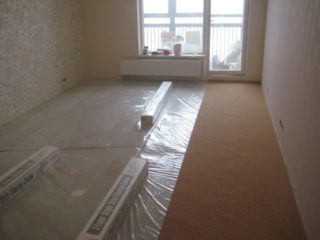
Vile it smoothes out only minor irregularities, so the floor is carefully leveled. The material is not subject to decay, but in rooms with high humidity it is better to spread polyethylene. There are models with a vapor barrier base. The rolled material should lie flat for a day. When laying, a gap of 1 cm is left near all walls. The canvases are not fixed to the floor, they are fastened together with tape.
Foamed polyethylene
The use of synthetic material is recommended in rooms with low traffic. It is laid on the concrete floor after leveling and high-quality cleaning of the screed. If the material is foil, then the shiny layer is directed upwards. The canvases are laid end-to-end, the seams are glued with tape.
Placing a linoleum underlay is not an obligatory stage in the installation of the floor covering. But the use of insulating materials speeds up construction work, increases comfort in the apartment and house.








